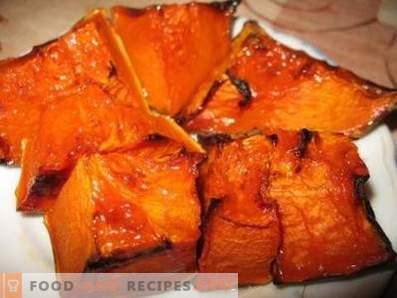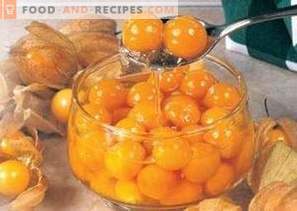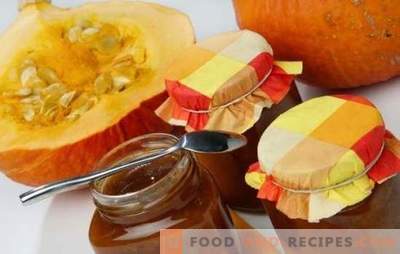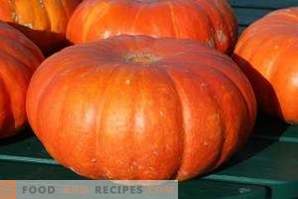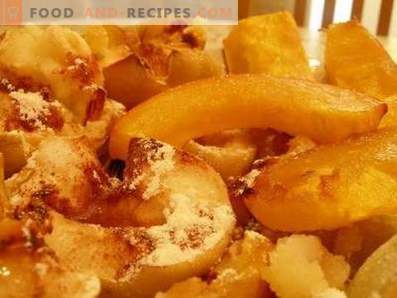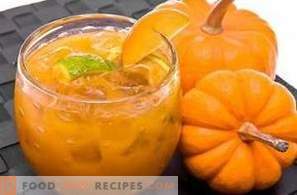
Autumn is a time to harvest pumpkins. Therefore, its market is most of all at this time. Round, flattened, pear-shaped fruit attracts the gaze of customers with its orange color and often impressive size.
People who know a lot about healthy nutrition do not bypass the pumpkin.
- A pumpkin, like no other vegetable, is rich in minerals, proteins, pectins, fiber. It contains vitamins: C, B1, B2, PP, A. Moreover, in some pumpkin varieties, the content of carotene is higher than in carrots.
- In addition to calcium, iron and potassium, it contains copper, magnesium, and cobalt.
- Pumpkin is recommended to include in the diet for diseases of the kidneys, liver, heart, as well as in violation of the bowels.
- One of the first vegetables included in the children's menu is the pumpkin. It does not cause allergic reactions and is well absorbed by the body.
Porridge with pumpkin, manti, casseroles, pancakes, vegetable stew is just a small list of dishes that include this orange vegetable.
Many housewives lay the pumpkin fruits for storage in order to use them in the winter as needed. In addition, pumpkin pickled, boiled jam from it. But it turns out that the pumpkin can be preserved in the form of juice.
Of course, pumpkin juice has a specific taste and aroma that cannot be confused with any other vegetable. But what amount of vitamins and other nutrients can be obtained by drinking a glass of pumpkin juice! Its taste can be easily corrected by adding to it the juice of any berries. Then even a sophisticated gourmet did not immediately determine what kind of drink he was served.
But pumpkin juice has one major drawback. Due to the lack of acid in its composition, it is poorly stored even in the refrigerator. Therefore, make it in a small amount so that you can drink, as they say, at a time. In order to preserve pumpkin juice until winter or even until the next season, it must be pasteurized or sterilized, followed by tight sealing.
But that's not all. Quality juice can be obtained only from the correctly selected pumpkin.
Pumpkin juice: cooking subtleties
- The pumpkin must be fully ripe. Only then will it be sweet and juicy.
- The best juice is obtained from nutmeg or Spanish varieties - because of the large amount of sugar in it.
- To make juice, you need to take a pumpkin that was recently ripped off the lash, because with long storage even such a hard-bodied fruit gradually loses its juiciness.
- The berries or fruit that will be used in the mix must be ripe, healthy and tasty. Most often, pumpkin juice is made with the addition of lemon or orange, citrus notes of which significantly enrich the taste of the juice and serve as a kind of preservative. For the same purpose, you can add citric acid to the juice.
How to make pumpkin juice
Making pumpkin juice is a snap. If you have a juicer or a juicer, then its preparation will be reduced significantly.
But do not be discouraged if you do not have these kitchen units. Juice can be made with the help of a blender, meat grinder, or a conventional grater, which practically any hostess has in her arsenal.
You will also need a large piece of gauze, a sieve with small cells, a colander, a sharp knife, a thick-walled saucepan for pasteurizing or cooking juice, and also sterile cans with tin lids. Here, perhaps, that's all. It remains only to roll up the sleeves and begin to prepare the juice.
Method 1
Ingredients:
- pumpkin - how much is in stock;
- lemon juice to taste;
- sugar - about 100 g per 1 liter of juice;
- water.
Preparation Method
- Wash the pumpkin. Despite the fact that you will cut the crust, germs from it can get on the pulp. And everything must be sterile. Cut the fruit in half, scrape the seeds with the surrounding fibrous pulp. Cut the pumpkin into slices, cut off the peel.
- If you use a meat grinder to grind pumpkin, chop the flesh into pieces so that they freely pass into the socket. Pass through a meat grinder with large cells.
- If you do not have a special press, fold the gauze in four layers, put the pumpkin mass on it, gather the fabric in a knot.
- Put the resulting bag in a colander, which is set on the pan. On the gauze with pumpkin, place a yoke. Wait for the juice to drain into the pan. You can help a little hands, squeezing the bag on both sides. Do not try to increase the pressure, otherwise the pumpkin pulp will score gauze, and the juice will stop flowing. You will get the juice of the first spin.
- Put the remaining pulp in the pan, add a little water in the ratio of 1:10, where the unit is the amount of water, heat to boil, but do not boil. Press the resulting mass. With the juice of the first extraction, the resulting juice should not be mixed. Use it to make jelly. Or you can add sugar with citric acid to taste and enjoy it with pleasure.
- And what to do with the juice of the first spin? Drain it into a clean enameled pan, add sugar and citric acid to taste. Heat to 90 ° (juice should be on the verge of boiling), pasteurize for 5-10 minutes until sugar is completely dissolved.
- When hot, pour into sterile, dry jars, preheated in an oven, hermetically sealed. Turn them down the neck, wrap a blanket, leave to cool.
Method 2
Ingredients:
- peeled pumpkin - 2, 5 kg;
- sugar - about 300 g;
- lemon - 0, 5 pcs .;
- water - approximately 0, 5-1 l.
Preparation Method
- Wash the whole pumpkin, cut it in half, remove the seeds and fibrous pulp in which they were located. Cut into slices, cut off the peel.
- Cut the peeled pumpkin into small pieces, fold into a wide saucepan or basin. Pour enough water to cover the bottom by 2 cm.
- Put the saucepan on a slow fire, stirring gently, cook until soft pumpkin. It will take you about forty minutes.
- Then transfer the contents of the pan to a bowl, chop with a dipping blender. Or put the pumpkin in a conventional blender and grind to a state of mashed potatoes.
- Put the sugar, pour in the lemon juice squeezed from the lemon, stir until the sugar has dissolved. If the mash is thick, add some hot water.
- Prepare a strainer that is placed on the pan. Spread pumpkin puree in small portions, using a spoon, wipe it through a sieve into a saucepan.
- Bring the pot to a juice over low heat almost to the boil. Juice should only be slightly swaying, but not boiling. Warm it for 10-15 minutes.
- Prepare sterile, well warmed jars with lids. Hot pour juice into them. Immediately seal hermetically.
- Turn them upside down, wrap them with a blanket, let them cool completely.
Method 3
Ingredients:
- pumpkin - 1 kg;
- water - 2 l;
- sugar - 0, 25 kg;
- lemon juice of one lemon.
Preparation Method
- Wash the pumpkin, cut it in half, remove the seeds and pulp that is in the middle. Cut the pumpkin into slices, peel. Rub on a medium grater. Fold in an enamel pot.
- In another pot, boil syrup out of water and sugar. Fill them with a grated pumpkin. Cook over low heat for 15-20 minutes, stirring so that the mass does not burn.
- Wipe it through a sieve. Pour the resulting juice into the pan, add the juice of one lemon and, if necessary, dilute with hot water to the desired consistency. At a temperature of 90 ° warm the juice for 10-15 minutes.
- When hot, pour pumpkin juice into sterile, dry jars, seal her. Turn the jars upside down, wrap a blanket. Leave to cool.
Note: If you do not have a sieve, grind the pumpkin in a blender. Adjust the juice thickness by adding hot water. Pasteurize as described above.
Mistress of the note
As you can see, in the preparation of juice is nothing complicated.
Many recipes do not specify a specific amount of sugar. The fact is that everything depends on the sweetness of the pumpkin and the tastes of the hostess (and the household, of course). Citric acid is also added to taste. It should be well felt in the juice, as it not only improves its taste, but also serves as a preservative.
In the finished form, the juice can be thick, almost viscous, and watery. It also depends on the amount of water added to the pumpkin puree.
The prerequisite is the warming of the juice before filling into cans and hermetic sealing. Only then the juice will sustain storage and will not turn sour.







